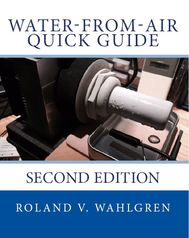Technical Information about water-from-air systems
Energy requirements
Energy sources include: grid, solar, fuel cells, and flared natural gas (on drilling platforms). Hybrid energy supplies are recommended for optimizing practicality and economical operation in tropical locations.
Water quality
Water droplets are collected from aluminum or copper-nickel coils coated with materials meeting US Food and Drug Administration regulations. The product water is similar to distilled water with extremely low (~ 0 ppm) total dissolved solids (TDS) content. Water stored in reservoirs in a tropical climate should undergo standard water treatment (for example, chlorination) to ensure compliance with World Health Organization drinking water standards. In contrast—other widely used desalination systems leave residual salt in the product water. Thermal desalination methods yield "fresh" water containing 5–50 ppm TDS. Reverse osmosis product water contains 300–500 ppm TDS.
Environmental Impact
Water-from-air systems do not produce harmful byproducts such as the brine (twice the concentration of the original seawater solution) produced by desalination plants. Desalination plant maintenance relies on chemical additives such as anti-scalants, surfactants, and acids. These accumulate in the local environment causing damage to ecosystems.
The saline groundwater used as a coolant in WaterProducer™ and WaterProducer-Greenhouse™ systems is returned unchanged (except for becoming a few degrees warmer) to the environment. Discharge is to an appropriate depth in the saline groundwater that is a similar temperature to the warmed coolant.
Technical Bulletins
We encourage you to read our technical bulletins for detailed discussions about water-from-air topics.
- WaterCondensator™—800 kWh/1000 L
- WaterProducer™—25–500 kWh/1000 L
- WaterProducer-Greenhouse™—25 kWh/1000 L
Energy sources include: grid, solar, fuel cells, and flared natural gas (on drilling platforms). Hybrid energy supplies are recommended for optimizing practicality and economical operation in tropical locations.
Water quality
Water droplets are collected from aluminum or copper-nickel coils coated with materials meeting US Food and Drug Administration regulations. The product water is similar to distilled water with extremely low (~ 0 ppm) total dissolved solids (TDS) content. Water stored in reservoirs in a tropical climate should undergo standard water treatment (for example, chlorination) to ensure compliance with World Health Organization drinking water standards. In contrast—other widely used desalination systems leave residual salt in the product water. Thermal desalination methods yield "fresh" water containing 5–50 ppm TDS. Reverse osmosis product water contains 300–500 ppm TDS.
Environmental Impact
Water-from-air systems do not produce harmful byproducts such as the brine (twice the concentration of the original seawater solution) produced by desalination plants. Desalination plant maintenance relies on chemical additives such as anti-scalants, surfactants, and acids. These accumulate in the local environment causing damage to ecosystems.
The saline groundwater used as a coolant in WaterProducer™ and WaterProducer-Greenhouse™ systems is returned unchanged (except for becoming a few degrees warmer) to the environment. Discharge is to an appropriate depth in the saline groundwater that is a similar temperature to the warmed coolant.
Technical Bulletins
We encourage you to read our technical bulletins for detailed discussions about water-from-air topics.
- Technical Bulletin No. 1 — WaterProducer™ and Reverse Osmosis Desalination Compared
- Technical Bulletin No. 2 — WaterProducer™ Cost, Features, and Benefits
- Technical Bulletin No. 3 — Carbonate Islands with Natural Coolant Resources for the WaterProducer™
- Technical Bulletin No. 4 — Comparing the WaterProducer-Greenhouse™ to the Seawater Greenhouse
- Technical Bulletin No. 5 — Environmental impact of widespread use of drinking-water-from-air systems
- Technical Bulletin No. 6 — Potential and limitations of water-from-air systems for horticulture in greenhouses at four tropical sites
Water-from-air International Lexicon
Water-from-Air Quick Guide (Book)
WaterCondensator™, CanDew-2500™, WaterProducer™, and WaterProducer-Greenhouse™ are trademarks claimed by Roland V. Wahlgren
